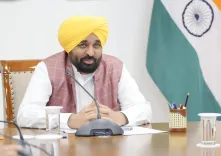How is India's strategic partnership with G7 set to enhance global trade?

Synopsis
Key Takeaways
- India's trade with G7 countries has risen significantly, showcasing its growing export competitiveness.
- The partnership focuses on key areas like renewable energy, climate finance, and digital infrastructure.
- India's demographic advantage supports economic growth and innovation.
- G7 nations face demographic challenges that could hinder their economic potential.
- Global cooperation on technology and AI governance is crucial for sustainable growth.
New Delhi, June 26 (NationPress) A strategic alliance focused on clean and renewable energy, climate finance, Digital Public Infrastructure, as well as trade and supply chain resilience, alongside healthcare and pharmaceuticals, is set to propel a mutually advantageous growth path between India and the G7 nations, as per a study published here on Thursday.
The report, unveiled by the PHD Chamber of Commerce and Industry, emphasized the significance of maritime and Indo-Pacific security as a crucial element that further strengthens the bond between India and G7 countries.
According to the findings, India's merchandise trade with G7 nations has skyrocketed by 61 percent, increasing from $154 billion in FY 2020–21 to $248 billion in FY 2024–25, while consistently maintaining a trade surplus. This surge demonstrates India’s enhancing export competitiveness, supported by the commodity net export price index, which reinforces its external sector resilience, the study noted.
Hemant Jain, president of the PHD Chamber of Commerce and Industry, stated, "India's steady GDP growth positions the country as a pivotal growth engine for the global economy. Transformative reforms such as the GST, the Insolvency and Bankruptcy Act, the Production Linked Incentive Scheme, and expanding digital infrastructure (Aadhaar, UPI) and 'Make in India' initiatives are propelling India’s rise on the global stage.
India has achieved an average real GDP growth exceeding 8 percent from 2021 to 2024, outpacing all G7 nations. Projections from the IMF for 2025 suggest that India will sustain an average growth rate above 6 percent through 2029, driven by robust domestic demand, solid macroeconomic fundamentals, and its demographic advantage.
The report also highlighted that in terms of purchasing-power-parity (PPP), India's share of global GDP has climbed from 7 percent in 2020 to 8.3 percent in 2024, and is expected to surpass 9 percent by 2029.
A critical factor is the demographic contrast between India and the G7. India’s working-age population (ages 15–64) is projected to grow, with over 68 percent of its population currently in this age bracket. This demographic dividend fosters an expansion in labor supply, enhances domestic consumption, and enriches the innovation landscape through a dynamic startup culture and increasing enrollment in tertiary education.
Moreover, the proportion of India’s population aged 65 and older is less than 5 percent (2025). In contrast, G7 countries are grappling with demographic challenges, as their share exceeds 10 percent, indicating rapidly aging populations, diminishing labor pools, and rising old-age dependency ratios.
By 2030, this percentage is anticipated to double or more for the G7 economies, which could hinder potential output, curtail consumer demand, and escalate fiscal pressures associated with pensions and healthcare, the report elaborated.
During his address at the G7 summit, Prime Minister Narendra Modi highlighted India's role in clean energy transition, climate action, and digital innovation. Major global initiatives spearheaded by India—such as the International Solar Alliance, Mission LiFE, and the Global Biofuels Alliance—are paving the way for a greener and more inclusive global community.
In the realm of technology and digital governance, India exhibited its dedication to a human-centered and ethical approach to AI, showcasing initiatives like BHASHINI and Digital Public Infrastructure (DPI) as exemplary global models. The Prime Minister called for international collaboration on AI governance, resilient tech supply chains, and the prevention of the misuse of emerging technologies.









